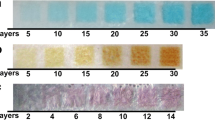Abstract
Purpose. pH modifiers are often used to promote drug solubility/stability in dosage forms, but predicting the extent and duration of internal pH modification is difficult. Here, a noninvasive technique is developed for the spatial and temporal mapping of pH in a hydrated pharmaceutical pellet, within a pH range appropriate for microenvironmental pH control by weak acids.
Methods. Confocal dual excitation imaging (Ex 488/Ex 568) of pellets containing a single, soluble, pH-sensitive fluorophore with cross-validation from a pH microelectrode. The technique was used to investigate the changing pH distribution in hydrating pellets containing two weak acids of differing solubility.
Results. The algorithm developed provided pH measurements over the range pH 3.5-5.5 with a typical accuracy of 0.1 pH units and with excellent correlation with pH microelectrode measurements. The method showed how pellets containing 25%w/w tartaric acid exhibited a rapid but transient fall in internal pH, in contrast to a slower more prolonged reduction with fumaric acid.
Conclusions. Spatial and temporal monitoring of pH in pellets was achieved with good accuracy within a pH range appropriate to pH modification by weak acids. However, the method developed is also generic and with suitable fluorophores will be applicable to other pH ranges and other dosage forms.
Similar content being viewed by others
REFERENCES
K. Thoma and T. Zimmer. Retardation of weakly basic drugs with diffusion tablets. Int.J.Pharm. 58:197-202 (1990).
K. Thoma and I. Ziegler. The pH-independent release of fenoldopam from pellets with insoluble film coats. Eur.J.Pharm.Biopharm. 46:105-113 (1998).
R. Bianchini, G.Bruni, A.Gazzaniga, and C.Vecchio. Influence of extrusion-spheronisation processing on the physical properties of d-indobufen pellets containing pH adjusters. Drug Dev.Ind.Pharm. 18:1485-1503 (1992).
M. Kohri, N. Miyata, M. Takahashi, and H. Endo, K. Iseki, K. Miyazaki, S. Takechi, A. Nomura. Evaluation of pH-independent sustained release granules of dipyridamole by using gastric acidity controlled rabbits and human subjects. Int.J.Pharm. 81:49-58 (1992).
G. M. Venkatesh. Development of controlled release SK & F 82526 J buffer bead formulations with tartaric acid as the pbuffer. Pharm.Dev.Tech. 34:477-485 (1998).
C. Van Der Veen, H. Buitendijk, and C. F. Lerk. The effect of acidic excipients on the release of weakly basic drugs from the programmed release megaloporous system. Eur.J.Pharm.Biopharm. 37:238-242 (1991).
K. E. Gabr. Effect of organic acids on the release patterns of weakly basic drugs from inert sustained release matrix tablets. Eur.J.Pharm.Biopharm. 38:199-202 (1992).
N. Kohri, H.Yatabe, K. Iseki, and K. Miyazaki. A new type of pH-independent controlled release tablet. Int.J.Pharm. 68:255-264 (1991).
C. Doherty and P. York. Microenvironmental pH control of drug dissolution. Int.J.Pharm. 50:223-232 (1989).
C. Kroll, K. Mader, R. Stober, and H. H. Borchert. Direct and continuous determination of pH values in nontransparent w/o systems by means of EPR spectroscopy. Eur.J.Pharm.Sci. 3:21-26 (1995).
K. Mader, S. Nitschke, R. Stosser, H. H. Borchert, and A. Domb. Nondestructive and localised assessment of acidic microenvironments inside biodegradable polyanhydrides by spectral spatial Electron Paramagnetic Resonance Imaging (EPRI). Polymer. 38: 4785-4794 (1997).
L. S. Cutts, S. Hibberd, J. Adler, M. C. Davies, and C. D. Melia. Characterising drug release processes with controlled release dosage forms using the confocal laser scanning microscope. J.Control.Release 42:115-124 (1996).
A. Shenderova, T. G. Burke, and S. P. Schwendeman. The acidic microclimate in poly(lactide-co-glycolide) microspheres stabilises Camptothecins. Pharm.Res. 16:241-248 (1999).
K. Fu, D. W. Pack, A. M. Kilbanov, and R. Langer. Visual evidence of acidic environment within degrading poly(lactic-co-glycolic acid)(PLGA) microspheres. Pharm.Res. 17:100-106 (2000).
R. Sanders, A. Draaijer, H. C. Gerritsen, P. M. Houpt, and Y. K. Levine. Quantitative pH imaging in cells using confocal fluorescence lifetime imaging microscopy. Anal.Biochem. 227:302-308 (1995).
K. W. Dunn, S. Mayor, J. N. Myers, and F. R. Maxfield. Applications of ratio fluorescence microscopy in the study of cell physiology. FASEB J. 8:573-582 (1994).
J. E. Whitaker, R. P. Haougland, and F. G. Prendergast. Spectral and photophysical studies of benzo[c]xanthene dyes: Dual emission pH sensors. Anal.Biochem. 194:330-344 (1991).
P. N. Dubbin, S. H. Cody, and D. A. Williams. Intracellular pH mapping with SNARF-1 and confocal microscopy. II: pH gradients within single cultured cells. Micron. 24:581-586 (1993).
S. Bassnett, L. Reinisch, and D. C. Beebe. Intracellular pH measurement using single excitation-dual emission fluorescence ratios. Am.J.Physiol. 258:171-178 (1990).
K. J. Buckler and R. D. Vaughan-Jones. Application of a new pH sensitive fluorophore (carboxy-SNARF-1) for intracellular pH measurement in small, isolated cells. Eur.J.Physiol. 417:234-239 (1990).
J. A. Thomas, R. N. Buchsbaum, A. Zimniak, and E. Racker. Intracellular pH measurements in Ehrlich ascites tumour cells utilising spectroscopic probes generated in situ. Biochem. 18: 2210-2218 (1979).
Y. Zhou, E. M. Marcus, R. P. Haugland, and M. Opas. Use of a new fluorescent probe, seminaphthofluorescein-calcein, for determination of intracellular pH by simultaneous dual-emission imaging laser scanning confocal microscopy. J.Cell Physiol. 164: 9-16 (1995).
J. Lui, Z. Diwu, and D. H. Klaubert. Fluorescent molecular probes III. 2', 7'-Bis-(3-carboxypropyl)-5-(and-6)-carboxyfluorescein (BCPCF): a new polar dual excitation and dual emission pH indicator with a pKa of 7.0. Bioorg.Mel.Chem.Lett. 7:3069-3072 (1997).
S. Mordon, J. M. Devoisselle, and S. Soulie. Fluorescence spectroscopy of pH in vivo using dual-emission fluorophore (C-SNAFL-1). J.Phytochem.Photobiol.B: Biol. 28:19-23 (1995).
L. S. Cutts, P. A. Roberts, J. Adler, M. C. Davies, and C. D. Melia. Determination of localised diffusion coefficients in gels using confocal scanning laser microscopy. J.Microscopy 180:131-139 (1995).
C. D. Melia, A. R. Rajabi-Siahboomi, A. R. and R. W. Bowtell. Magnetic resonance imaging of controlled release pharmaceutical dosage forms. Pharm.Sci.Tech.Today 1:32-39 (1999).
J. Adler, A. Jayan, and C. D. Melia. Quantifying differential expansion within hydrating hydrophilic matrices by tracking embedded fluorescent microspheres. J.Pharm.Sci. 88:371-377 (1999).
United States Pharmacopoeia 24. United States Pharmacopeial convention. 1999.
S. Budavari. Ed. The Merck Index. Twelfth Edition. Merck & Co Inc, New York, 1996
Author information
Authors and Affiliations
Corresponding author
Rights and permissions
About this article
Cite this article
Cope, S.J., Hibberd, S., Whetstone, J. et al. Measurement and Mapping of pH in Hydrating Pharmaceutical Pellets Using Confocal Laser Scanning Microscopy. Pharm Res 19, 1554–1563 (2002). https://doi.org/10.1023/A:1020425220441
Issue Date:
DOI: https://doi.org/10.1023/A:1020425220441




